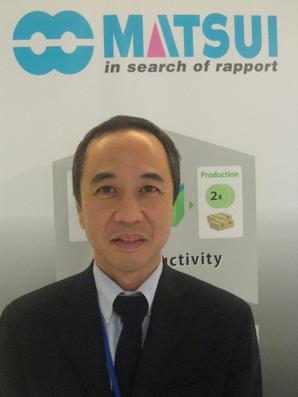By Steve Toloken
STAFF REPORTER / ASIA BUREAU CHIEF
Published: November 5, 2013 3:58 pm ET
Updated: November 5, 2013 5:52 pm ET

Image By: Steve Toloken
Hironobu Matsui, president of Osaka, Japan-based plastics equipment maker Matsui Manufacturing Co. Ltd.
HONG KONG — 3D printing gets a lot of attention as a potential equalizer in global manufacturing. The typical story is that the technology can help companies in developed economies like the United States or Japan be more nimble and make tailored products to better compete against the low-cost, mass production economies like China.
But before breaking out the champagne, it's worth noting that the technology, also called additive manufacturing, is attracting a lot of interest in some of those lower-cost countries.
Hong Kong's plastics injection molding industry, for example, is taking a hard look, as it sees the low-cost advantages of its mainland Chinese factories disappearing rapidly.
About 200 plastics executives and engineers packed a recent 3D printing and plastics conference organized by Hong Kong's trade associations. Most of their attention focused on lowering costs in mold making, traditionally a strong suit of Hong Kong, and speeding up product development. But there also was interest in using it in full-scale manufacturing.
Making an injection mold with 3D printing, by adding thin layers of metals on top of each other inside the printer, can dramatically cut manufacturing time. It's technically complicated but becoming more popular.
Japan's Panasonic Corp., which holds key patents in the technology, said in June that its Ecosolutions business unit plans to make half its yearly output of 5,000 molds, including molds for mass production, using 3D printing.
The technology can produce more efficient molds, said Hironobu Matsui, president of Osaka, Japan-based plastics equipment maker Matsui Manufacturing Co. Ltd., speaking at the Nov. 1 conference, sponsored by the Hong Kong Plastics Manufacturers Association and the Hong Kong Plastics Industry Council.
"It is not so simple yet but we can do it," Matsui said. "We can make complicated molds faster because the whole mold can be made in one process."
A key advantage is that a 3D-printed mold can be made with better conformal cooling channels than traditional mold making, substantially reducing the cooling time of the mold in the injection machine and making the manufacturing of the ultimate plastic part cheaper and more energy efficient, he said.
"This cooling channel is impossible by the conventional process," Matsui said. "It has a great impact on mass production."
Some of the manufacturers at the event were not so sure. Jessica Leung, business development director for Hong Kong housewares molder Star Industrial Co. Ltd., said it's not clear if molds made with 3D printers are durable enough, although she said she sees potential for product development.
The head of one of Hong Kong's plastics trade associations said local companies are very interested in additive manufacturing as costs rise in their mainland Chinese factories. Wages on average have risen more than 10 percent a year for half a decade, and land and electricity costs are up as well.
"Our advantage in the last 20 years has disappeared. We were bound to succeed, everything was so cheap but all the advantages are disappearing," said Daniel Wong, chairman of the Hong Kong Plastics Industry Council. "We have to look at how to improve productivity."
Some companies saw 3D printing as a potentially valuable tool in product development. 3D printers can use both metal and plastic as their raw material.
Bernie Ting, general manager of plastic toy maker Qualidux Industrial Co. Ltd., was at the seminar with three staff members, a mold maker, an engineer and an industrial designer, to study how the technology could make it much cheaper to develop samples of new products.
"3D printing will help prototyping in a cost effective way, and that brings business opportunities," Ting said. "In the old days, it was very expensive. Hopefully this will lower the costs."
The technology for additive manufacturing has been used in prototyping for two decades, but the cost of the equipment is dropping rapidly as early patents expire, said Bryan So, a senior consultant with the Hong Kong Productivity Council, a quasi-government agency that provides services to local manufacturers. The HKPC has 3D printers available in its labs for local manufacturers to try.
So and several speakers at the event also said U.S. President Obama's mention of 3D printing in his State of the Union speech in February stoked interest, even in China.
Some saw the technology as complementary to existing practices, rather than a replacement, that can be used in short-run production.
3D printer maker Stratasys Ltd. presented an example of a prototype mold 3D printed from ABS plastic, with other plastic then injected into that mold to make the part. It said the ABS mold could handle at least 100 injection cycles, but its big advantage was it could be made in one day, instead of 30 days for steel and aluminum molds, at less than half the cost.
"Let's be clear, we cannot replace CNC in mold making," said Alex Hodik, application manager in the Hong Kong office of Stratasys, which has joint headquarters in the United States and Israel. "We are looking at it as a complementary system"
There was also buzz at the conference about the recent announcement from German injection molding machine maker Arburg GmbH and Co. that it was now making 3D printers, making it the first plastics equipment company to do so. Arburg touts the machine as capable of making commercial parts, direct from a CAD file and without a mold.
Alfred Au, an executive committee member of the Hong Kong Mould & Die Council, called it an important development because Arburg has a richer understanding of the plastics industry than most 3D printer makers.
For example, Au said the Arburg machine can use standard resins, rather than requiring specialized and more expensive plastics available only from the 3D printer manufacturer.
He said he inspected the Arburg machine, called the Freeformer, in October at the K Fair in Germany, where it was unveiled. He praised it but said it needs work.
"The direction is right but they need time to prove it," said Au, who is also technical director for Hong Kong molder Lucky Star (Holdings) Ltd. "It's a good beginning because Arburg has the know-how to inject resin."
Another company with experience in the plastics equipment industry, Japan's Sodick Co. Ltd., plans to unveil its own version of a 3D metal printing machine for mold making in late 2014, using technology licensed from Panasonic, according to a speaker from Japanese software maker OPM Laboratory Co. Ltd.
Panasonic's patents cover how to combine 3D printing and metal milling processes inside the same machine, Matsui said.
Several speakers and attendees said having more companies making the equipment will lower the costs, which has been a barrier to having additive manufacturing expand beyond the specialized prototyping world.
Even with the sometimes high cost of equipment, interest is high in China. The Wohlers Report, one of the industry bibles of additive manufacturing, noted that the Chinese government is investing $245 million in a seven-year project to rapidly grow its 3D printing industry. Beijing wants to set up 10 institutes for the industry. Japan and Singapore are also investing in creating a 3D infrastructure.
"Every time we organize a 3D printing seminar, hundreds of people show up," said HKPC's So. | 